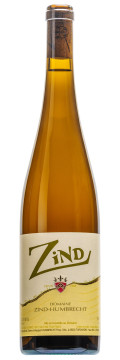
Technical presentation
| Bottling : | January 2025 |
|---|---|
| Acquired alcohol : | 12.5 ° |
| Residual sugar : | Less than 0.5 g/l |
| Total acidity : | 3.3 g/l H2SO4 (5.1 g/l Acide Tartrique) |
| pH : | 3.27 |
| Yield : | 57 hl/ha |
| Optimum tasting : | 2026-2038 |
| Average age of vines : | 34 years |
| Grape variety : | Chardonnay / Auxerrois |
| Terroir : | Clos Windsbuhl |
| Sweetness index : | 1 |
| Soil : | Muschelkalk calcareous |
| Format : | 75 cl |
Description of the wine Zind 2023
The vines used in this blend were planted in 1989. Chardonnay, reserved exclusively for the AOP Crémant d'Alsace, was chosen instead of Pinot Blanc because the late limestone terroir of Windsbuhl is particularly suited to it. Muschelkalk (Triassic shell limestone) is a rock that splits easily and allows the roots to descend nicely. It is also a limestone poor in clay, which explains the bright and vivacious structure of the wines. In 1989, it was also much easier to find quality plant material on this grape variety. The proximity of the imposing Vosges forest accentuates the freshness of the microclimate of this terroir located at altitude. The vinification is done in oak barrels with ageing on total lees for 16 months, so no intervention or racking before bottling.

Tasting notes
1/2025: Pale yellow colour. The nose is still closed, marked by a brief reduction that is often found on this terroir in sunny vintages which is amplified by the total lees contact. Aeration or decanting will reveal an aromatic palette of citrus fruits, aromatic plants, white fruits. The palate is both precise and incisive and provides a real salivation pleasure. The acidity is ripe, sharp without being excessive, and reinforces the dry character of the wine. We also find a classic signature of the 2023: beautiful structuring tannins. This Zind 2023 is a delicate and imposing wine at the same time.

The Clos Windsbuhl of Hunawihr
The altitude of the vineyard coupled with Hunawihr’s tardy climate means that the Clos Windsbuhl is often one of the last of our vineyards to be harvested. This explains the aromatic quality of the Clos’ wines and the consistent balance of acidity, a guarantee of good ageing. Although often harvested late, the Windsbuhl grapes are only rarely botryitized, doubtless due to the altitude of the vineyard, but nevertheless often reach high levels of maturity.
